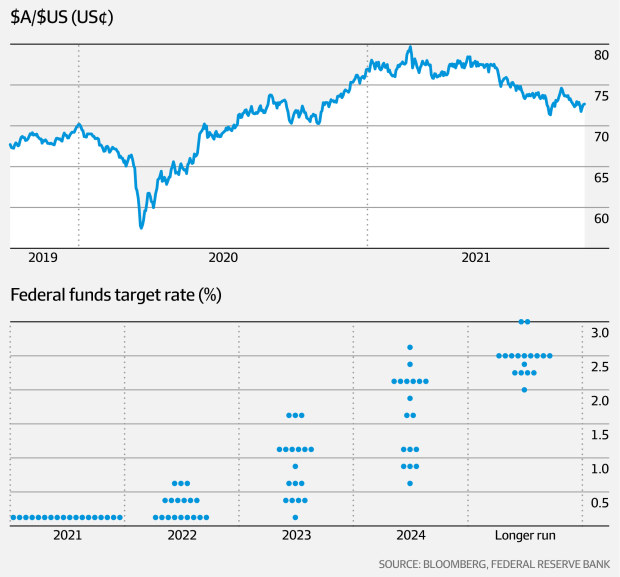Federal Reserve and China weigh on $A outlook

Economists have downgraded their forecasts for the Australian dollar in the expectation that the US Federal Reserve is getting further in front of the Reserve Bank’s timeline for monetary tightening, despite the currency already trading below fair value because of the bear market in iron ore.
The median forecast from The Australian Financial Review’s quarterly survey of 26 economists predicts the Australian dollar appreciating to US74¢ by December and remaining stable for the year through December 2022. The December 2021 projection is down from a US78¢ forecast in the June quarter survey.

The $A traded at US72.96¢ on Monday amid questions over the future of stricken Chinese property developer Evergrande, and an energy crisis putting China’s growth rate at risk, .
“The Australian dollar is easily the weakest G10 currency over the past three months,” said Sean Callow, senior currency strategist at Westpac.
A large contributor to the Aussie’s downgrade is the widening US-Australian interest rate differential. Financial markets expect the Federal Open Market Committee (FOMC) to start raising interest rates as early as next year, from the zero-to-0.25 per cent level where they have plateaued since March 2020, as the US economy recovers from the pandemic.
In contrast, Reserve Bank Australia governor Philip Lowe reiterated last month he will not increase the cash rate, currently at 0.1 per cent, before 2024, which is when the RBA expects actual inflation to be sustainably within the targeted 2 per cent-to-3 per cent range.
“We expect the FOMC to begin its hiking cycle in the December quarter next year, providing the RBA with a helpful lead, while Bank of Canada and Bank of England are expecting to begin raising the policy rate sometime in the second half of 2022,” said Bill Evans, chief economist at Westpac. Tightening by central banks is “not as far away” as initially expected.
Just last month, Norway became the first advanced economy to deliver a post-crisis interest rate increase, with the Reserve Bank of New Zealand widely expected to follow suit on Wednesday.
Financial markets are pricing in an Australian cash rate of about 0.25 per cent by the end of calendar 2022, 0.75 per cent by end‑2023 and close to 1 per cent by end‑2024; only two economists out of the 26 polled think the cash rate will be higher than the current, and record low, 0.1 per cent by December next year.
The important question is how soon the Fed will start raising its target rate and how aggressive the tightening cycle will be, says Brendan Rynne, chief economist at KPMG.
“We do not expect such a long gap this time because the Fed and markets are better prepared for this process, which caused some disruption because of the way it was implemented.”
In 2013, the Fed clumsily signalled a withdrawal of stimulus, sparking a surge in global borrowing costs because the market was only partially attuned to the risk.
Cloudy China
The biggest cloud over the Australian dollar’s outlook are concerns about China. The market often uses the $A as a liquid proxy to hedge against weakness, or wager on strength, in China’s economy.
“Evergrande is yet to be resolved,” said AMP Capital chief economist Shane Oliver, predicting a company restructuring. Its shares were halted from trading in Hong Kong on Monday.
A softening in Chinese economic growth as Beijing puts its stamp on property, technology and education is inflaming concerns.
“The credit tightening in China can worsen the global growth slowdown and lead to further US dollar strength,” said Commonwealth Bank senior currency strategist Elias Haddad.
Large sections of global activity appear to be contracting following a strong rebound during the first and second quarters, as stimulus is being withdrawn and the delta variant of COVID-19 dents confidence.
“The US dollar is trading near a one-year high,” said Mr Haddad. “The combination of slower global growth momentum and rising inflation pressures will likely generate additional financial market turbulence and underpin a firmer US dollar.”
Iron ore
Benchmark iron ore prices have slumped to about $US110 per tonne, from 2021 peaks north of $US230 a tonne. Economists expect further weakness as China curtails steel production and Brazil ramps up supply after years of production problems.
Paul Bloxham, chief economist for Australia and New Zealand at HSBC, forecast iron ore price to average $US90 a tonne in 2022. “This is expected to weigh on Australia’s national income growth and on tax revenue, which, combined with increased government spending due to the delta outbreak, is set to worsen the fiscal position,” he said.
That view is shared by Stephen Anthony, chief economist at Macroeconomics, predicting $US80 per tonne by December, while BetaShares chief economist David Bassanese forecasts $US60 per tonne over the next three-to-six months.
Other analysts, however, are more optimistic. Morgans chief economist Michael Knox predicts iron ore prices back in the range of $US120 to $US140 per tonne in 2022, and $US110 per tonne for QIC chief economist Matthew Peter.
“Australia’s iron ore is produced at very low marginal cost and at current prices production is still very profitable,” said Mr Peter.
The Reserve Bank holds its monthly policy meeting on Tuesday when it is certain to keep the cash rate unchanged.
Subscribe to gift this article
Gift 5 articles to anyone you choose each month when you subscribe.
Subscribe nowAlready a subscriber?
Introducing your Newsfeed
Follow the topics, people and companies that matter to you.
Find out moreRead More
Latest In Currencies
Fetching latest articles